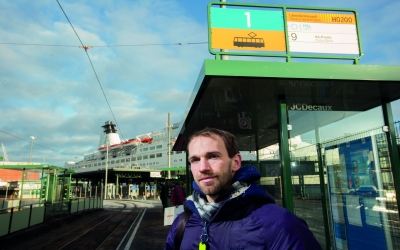
HSL interviewed passengers at the ports in Helsinki, asking how did they travel to the port. Over half of the respondents whose place of departure was within the city told they traveled by tram. Tram was the most common mode of transport on journeys originating in Helsinki both as the main mode of transport, i.e. the mode used for the longest leg of the journey, and as the last mode of transport, i.e. the mode by which passengers arrive at the port.
If all journeys to the ports are considered regardless of the place of departure, trams were the second most common last mode of transport, with a share of just under one third of journeys. The most common last mode of transport was car, with over 40 per cent of respondents having arrived at the port by car.
Car was also the most common main mode of transport among all respondents, with a share of 45 per cent.
Mostly car was used by those traveling from outside the capital region, but also half of passengers from Espoo, Vantaa and Kauniainen traveled by car.
Respondents whose main mode of transport was bus, train, tram or Metro, were mostly from central Helsinki or areas along the main or coastal rail lines.
The second most popular main mode of transport was bus, used by 17 per cent of all respondents. Train was the main mode of transport for 11 per cent of respondents, the tram for another 11 per cent.
Respondents were roughly divided into those who made the whole journey by public transport and those who did not use public transport at all. In other words, relatively few respondents combined car and public transport.
There was some variation by port: at the West Harbor, nearly half of passengers reported car as their main mode of transport. In the case of the South Harbor, car was the main mode of transport for under 40 per cent of passengers, with correspondingly higher shares of public transport and walking.
When motorists were asked why they did not use public transport, the most important reason was the need for a car either in the country of origin or at the destination, not so much the lack of public transport services.
“In our planning, we pay special attention to the needs of passengers toing to the passenger ports,” says HSL’s public transport planner Lauri Räty. “There is more seasonal variation due to tourism and bank holidays and there must be more flexibility in the supply.
“When developing public transport services, we have tried to separate services for ferry passengers from other services. For example, we have had good experiences of the new tram route 5 that started operating to the Katajanokka terminal in summer 2016. The timetables can be adjusted to the varying ferry timetables and passenger numbers.”
HSL conducted a passenger transport survey at the Olympia, Makasiini and Katajanokka terminals of the South Harbor, at the West Terminal and at the Hansa Terminal in Vuosaari in September/October 2016. Some 2,300 passengers responded to the survey.